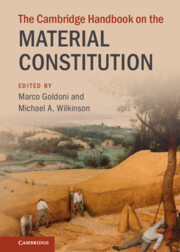Book contents
- The Cambridge Handbook on the Material Constitution
- The Cambridge Handbook on the Material Constitution
- Copyright page
- Contents
- Contributors
- Introduction
- Part I History
- 1 The Tradition of the Material Constitution in Western Marxism
- 2 The Soul of the State
- 3 Laski’s Materialist Analysis of the British Constitution
- 4 Rudolf Smend’s Legacy in German Constitutional Theory
- 5 The Constitution in the Material Sense According to Costantino Mortati
- 6 The Material Constitution of the Dual State
- 7 ‘A Certain Shadowy Totality’
- 8 The Material Constitution in Greek Constitutional Thought
- 9 The Constitution As Social Compromise
- 10 ‘Self-Justifying Law of Constitutional Law’
- Part II Challenges
- Part III Analyses
- Index
1 - The Tradition of the Material Constitution in Western Marxism
from Part I - History
Published online by Cambridge University Press: 15 January 2023
- The Cambridge Handbook on the Material Constitution
- The Cambridge Handbook on the Material Constitution
- Copyright page
- Contents
- Contributors
- Introduction
- Part I History
- 1 The Tradition of the Material Constitution in Western Marxism
- 2 The Soul of the State
- 3 Laski’s Materialist Analysis of the British Constitution
- 4 Rudolf Smend’s Legacy in German Constitutional Theory
- 5 The Constitution in the Material Sense According to Costantino Mortati
- 6 The Material Constitution of the Dual State
- 7 ‘A Certain Shadowy Totality’
- 8 The Material Constitution in Greek Constitutional Thought
- 9 The Constitution As Social Compromise
- 10 ‘Self-Justifying Law of Constitutional Law’
- Part II Challenges
- Part III Analyses
- Index
Summary
The aims of this chapter are, first, to track the development of the notion of the material constitution in selected authors associated with Western Marxism and, second, to explain its intermittent presence in the Marxist canon.The chapter focuses on four turning points in the social and intellectual history of the material constitution: its Marxist origins in the second half of the nineteenth century (Karl Marx and Ferdinand Lassalle, who coined the term); the crucial years of the Soviet revolution and the First World War(Vladimir Lenin and Rosa Luxemburg); the interwar period (Antonio Gramsci); and the tail end of the twentieth century (Étienne Balibar and Antonio Negri). At each turning point, a certain slack between the concrete constitutional order and the codified or written constitution has pushed scholars to revisit the material constitution. Although the chapter registers the decline of interest in the material constitution after the Second World War, it also underscores that the series of crises over the last two decades have again pushed the notion to the centre stage of constitutional enquiry. The chapter thus highlights the insight offered by these authors for understanding the material constitution in the twenty-first century.
- Type
- Chapter
- Information
- The Cambridge Handbook on the Material Constitution , pp. 25 - 44Publisher: Cambridge University PressPrint publication year: 2023

